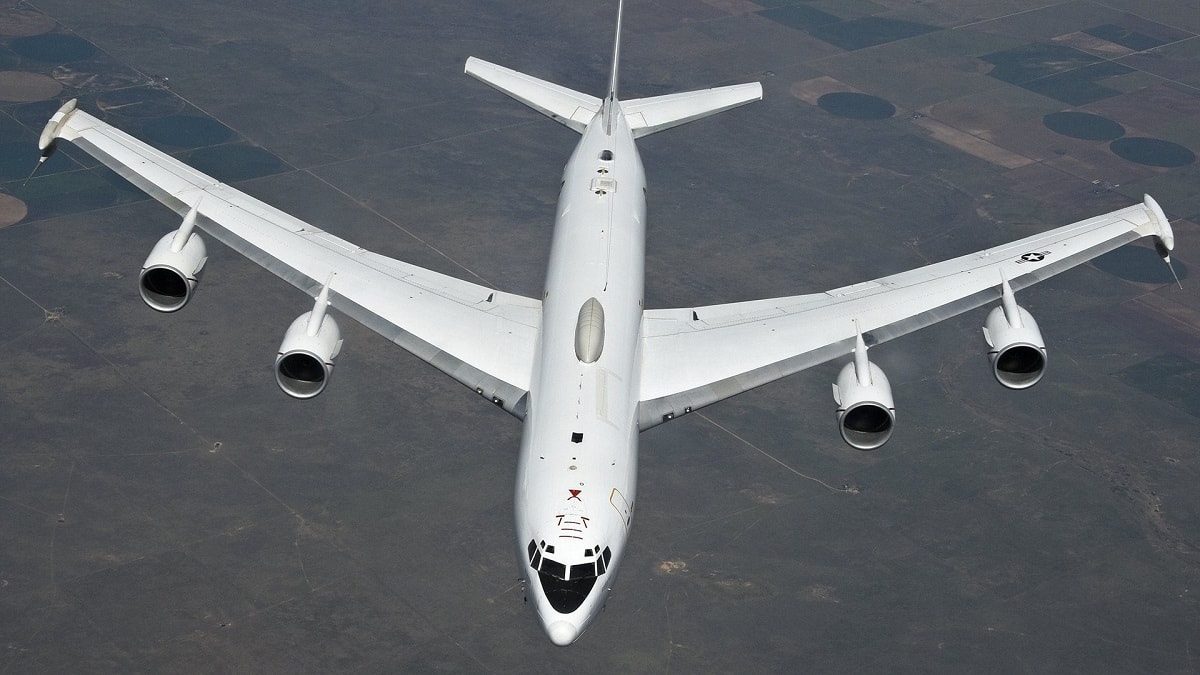A former member of the U.S. Air Force explains what you need to know about the E-6: The United States operates an airborne command and control center. Known as Looking Glass, or more formally as the Airborne National Command Post, the command center is an aircraft charged with controlling the U.S. military’s sprawling nuclear arsenal in the event that ground-based command centers are destroyed or disabled.
Under such circumstances, the general officer onboard the Looking Glass aircraft would undertake the role of Airborne Emergency Action Officer, under which he or she would assume authority over the National Command Authority – meaning that officer could give the orders to execute nuclear attacks.
For this reason, Looking Glass will typically fly with an admiral or general onboard. And the aircraft used for Looking Glass, with the capacity to unleash the United States’ awesome nuclear power, is the Boeing E-6 Mercury.
Meet the E-6
The E-6 is a modified version of Boeing’s 707 airliner. The 707 is a long-range, narrow-body passenger jet that was first flown in 1954 and is widely credited with kicking off the Jet Age. But whereas the 707 buses passengers, stacked six-abreast, from destination to destination, the E-6’s 22-person crew can coordinate a nuclear attack. “Though the Mercury doesn’t carry any weapons of its own, it may be in a sense be the deadliest aircraft operated by the Pentagon,” my colleague Sebastien Roblin writes. “Its job is to command the launch of land-based and sea-based nuclear ballistic missiles.”
The E-6 mission is known as “Take Charge and Move Out,” or TACAMO. Before the E-6, which debuted in the late 80s, the EC-130 served in the TACAMO role. The EC-130 is a modified version of Lockheed’s C-130 Hercules – the fantastically rugged, four-prop transport plane. Its successor is faster, with a higher ceiling and a wider range. With fuel-efficient CFM-56 turbojets and larger fuel tanks, the E-6 can remain airborne for 15 hours without refueling. With in-air refueling, the E-6 can remain airborne for three full days.
However, the E-6 does not use the probe-and-drogue refueling method. Instead, the Mercury relies on a flying boom receptacle on the upper-forward fuselage, meaning the E-6 can only receive in-air refuels from a few U.S. Air Force tankers: the KC-135 Stratotanker, the KC-10 Extender, and the KC-46 Pegasus.
One of the E-6’s more peculiar features are the trailing Very Low Frequency radios, or VLF. To use its VLF radios, the E-6 flies in a repetitive orbit, at high altitudes, trailing its two VLF radios – one on a one-mile wire, the other on a five-mile wire. Once deployed, the radios can communicate with submerged Ohio-class nuclear submarines. Curiously, the VLF has a very limited bandwidth, so, they can only transmit data at roughly thirty-five alphanumeric characters per second. That’s slow. It’s slower than your 1990s era, dial-up modem. Regardless, the VLF is quick enough to send the messages it needs to send: instructions to launch a nuclear attack. In addition to VLF, the E-6 also has ultra-high-frequency radios, allowing the aircraft to fire land-based ballistic missiles.

E-6 Mercury. Image Credit: Creative Commons.
Currently, in service with two Navy Fleet Air Reconnaissance Squadrons, the E-6 is expected to serve until 2040. Hopefully, it will never be called upon to give nuclear launch orders, as the plane was designed to do.
Harrison Kass is a Senior Defense Editor at 19FortyFive. An attorney, pilot, guitarist, and minor pro hockey player, he joined the US Air Force as a Pilot Trainee but was medically discharged. Harrison has degrees from Lake Forest College, the University of Oregon, and New York University. He lives in Oregon and regularly listens to Dokken.

